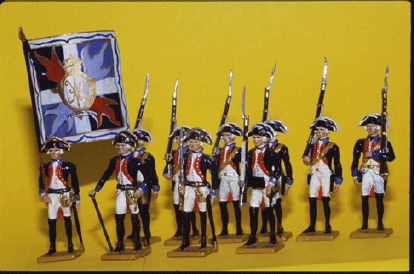|
54mm Handpainted "Rose Miniatures" Alloy
Model-soldiers
Colonial
Wars and Punitive Expeditons
Britain's Colonial wars were of three broad
, though not always distinct , types : campaigns
of conquest or annexation, campaigns
for the suppression of insurrectio and lawlessness and punitive
exeditions designed to avenge a wrong or wipe out an insult. The
Zulu Wars can be considered a campaignof conquest or annexation for this reason
: (
News from History of the British Army- Edited byP.Young and J.P.Lawford -1970)
Zulu War, 1879
Introduction
After the Conservative victory in the 1874 British General
Election, Lord Carnarvon was appointed
Secretary of State for the Colonies. In 1877 Carnarvon sent
Sir Bartle Frere to southern Africa as
British High Commissioner with the intention of creating a
federal dominion of the British colonies and
Boer Republics. To implement Carnarvon's policy, Frere had to
gain control over Zululand, a kingdom
bordering Natal and the Transvaal. After Cetshwayo, the Zulu
king, had refused to disband his army and
surrender land to the Transvaal, a British force commanded by
Lieutenant-General Lord Chelmsford invaded
Zululand in January 1879. The Zulus proved to be formidable
opponents, fast moving, courageous under fire
and adept in hand-to-hand combat. Most of the actions
fought during the war hinged on whether British
firepower could keep the Zulus at bay. Cetshwayo's Zulu army
was finally destroyed at Ulundi on 4 July
1879 but not before it had inflicted a devastating defeat on
the British at Isandlwana on 22 January.
The Battle of Isandlwana, 1879
Isandlwana and Rorke's
Drift
Chelmsford's invasion force was split into three columns. The
right column, under Colonel Charles Pearson.
crossed into Zululand near themouth of the Tugela River
with the aim of securing the abandoned mission at
Eshowe as a base for further operations. The left column,
under Colonel Evelyn Wood, entered Zululand
from the Transvaal while the centre column, which Chelmsford
himself accompanied, crossed the Buffalo
River
at Rorke's Drift
to seek out Cetshwayo's army. Underestimating the Zulus' speed of movement and
fighting
ability, Chelmsford split his column. On 22 January 1879 his
camp. under the command of Lieutenant-Colonel
Henry Pulleine, was surprised by the main Zulu army. The camp
had not been adequately prepared to resist
an attack and Pulleine's troops were dangerously strung out.
Eventually Pulleine's over-extended line was
swamped by sheer weight of numbers and the majority of his
1,700 troops were massacred. Some 4,000 Zulus
pressed on to
the Mission of Rorke's Drift where one Company of the 2nd Battalion 24th (The 2nd
Warwickshire)
Regiment of Foot , members of the Royal Engineer , Native Natal
Contingent , Royal Army Medical Deparment
and Commisariat and Transport Deparment
held them off for twelve hours. This was a welcome boost to
British
morale after the disaster of Isandlwana, but it had little effect on the campaign as a whole.
Khambula
Meanwhile, Pear-son's column had defeated 6,000 Zulus at
Nyezane and occupied Eshowe. Hearing of the
defeat at Isandlwana, Pearson fortified the post and remained
there, blockaded by the Zulus.
In the north Wood's column had withdrawn to a camp at
Khambula where, on 29 March, they defeated a
major Zulu attack, inflicting at least 3.000 casualties. Wood
knew that the Zulus were going to attack
for part of his force had run into them at Hlobane the
previous day. and so he had prepared accordingly.
His men were well dug in and were able to concentrate
their fire to devastating effect. As the Zulus
began to fall back, their retreat was turned into a rout by
Lieutenant-Colonel Redvers Buller's irregular
cavalry who pursued them mercilessly. Khambula proved a
crushing blow to Zulu morale. On 2 April Chelmsford
defeated a Zulu force at Gigindhlovu and evacuated the Eshowe
garrison. By the end of April most of
Chelmsford's men were back in Ulundi, Natal. At the end of
May, Chelmsford invaded Zululand again,
this time with a reinforced army. Despite problems of supply,
constant skirmishing and the embarrassing
death of the French Prince Imperial while on a patrol,
Chelmsford's force made steady progress.
On 4 July 1879 he drew up his
army in a large square opposite to Cetshwayo's capital at Ulundi.
The Zulus attacked in their
usual fashion but after less than an hour their charges petered out and the
17th
(The Duke of Cambridge's Own)
Lancers drove them from the field.
Cetshwayo was later hunted down and captured, the Zulu
monarchy suppressed, and Zululand was divided
into autonomous areas. Civil war followed and in 1883. in an
unsuccessful attempt to restore order,
the British restored Cetshwayo to his throne, though with
greatly reduced powers. He died the following year.
In 1887 Zululand was
declared British territory and annexed to Natal ten years later.
(
News from
the
relevant Home
page of National Army Museum)
(
Other details from the popular film " Zulu " directed by Cy Endfield
-1960)
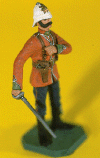 Ro.022) Rorke's
Drift battle 22÷23 January 1879
Ro.022) Rorke's
Drift battle 22÷23 January 1879
Lieutenant Gonville Bromhead 2nd
Bn. 24th Foot ( 2nd Warwickshire )
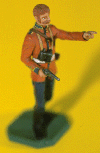 Ro.023) Rorke's
Drift battle 22÷23 January 1879
Ro.023) Rorke's
Drift battle 22÷23 January 1879
Lieutenant John Rouse Merriott Chard
Royal Engineers
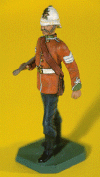 Ro.024) Rorke's
Drift battle 22÷23 January 1879
Ro.024) Rorke's
Drift battle 22÷23 January 1879
Colour Sergeant with cane 2nd
Bn. 24th Foot ( 2nd Warwickshire )
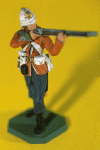 Ro.025) Rorke's
Drift battle 22÷23 January 1879
Ro.025) Rorke's
Drift battle 22÷23 January 1879
Private Frederick Hitch standing , firing 2nd
Bn. 24th Foot ( 2nd Warwickshire )
 Ro.026) Rorke's
Drift battle 22÷23 January 1879
Ro.026) Rorke's
Drift battle 22÷23 January 1879
Private Henry Hook running from hospital 2nd
Bn. 24th Foot ( 2nd Warwickshire )
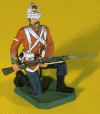 Ro.027) Rorke's
Drift battle 22÷23 January 1879
Ro.027) Rorke's
Drift battle 22÷23 January 1879
Private Robert Jones kneeling defensive 2nd
Bn. 24th Foot ( 2nd Warwickshire )
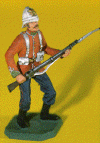 Ro.028) Rorke's
Drift battle 22÷23 January 1879
Ro.028) Rorke's
Drift battle 22÷23 January 1879
Private William Jones on guard 2nd
Bn. 24th Foot ( 2nd Warwickshire )
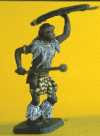 Ro.029) Rorke's
Drift battle 22÷23 January 1879
Ro.029) Rorke's
Drift battle 22÷23 January 1879
Batchelor warrior with large shield and Knobkerry
 Ro.030) Rorke's
Drift battle 22÷23 January 1879
Ro.030) Rorke's
Drift battle 22÷23 January 1879
Batchelor warrior throwing assegai
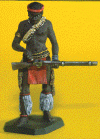 Ro.031) Rorke's
Drift battle 22÷23 January 1879
Ro.031) Rorke's
Drift battle 22÷23 January 1879
Married warrior loading Martini Henry rifle
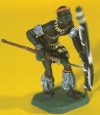 Ro.032) Rorke's
Drift battle 22÷23 January 1879
Ro.032) Rorke's
Drift battle 22÷23 January 1879
Married warrior with stabbing assegai
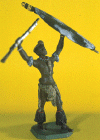 Ro.033) Rorke's
Drift battle 22÷23 January 1879
Ro.033) Rorke's
Drift battle 22÷23 January 1879
Married warrior wawing Martini Henry rifle
 Ro.034) Rorke's
Drift battle 22÷23 January 1879
Ro.034) Rorke's
Drift battle 22÷23 January 1879
Induna drumming assegai on shield
 Ro.035) Rorke's
Drift battle 22÷23 January 1879
Ro.035) Rorke's
Drift battle 22÷23 January 1879
The 2nd Bn. 24th Foot ( 2nd Warwickshire ) and the zulu warriors
(Miniatures
from Rose Catalogue -Spring Supplement 1977)
(Details
from " Infantry Uniforms" Blandford Press 1970)
| 